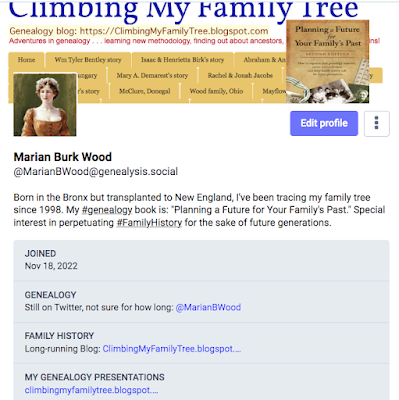Last night and this morning, the #GenChat topic (on Twitter and Mastodon) was "Bite-Sized Ancestor Bios." To stimulate conversation as guest expert, I created a series of questions that participants answered in tweets or toots. Here's a recap--lots of ideas and food for thought! No right or wrong answers. "Everyone deserves to be remembered" as
GenChat host Christine says.
#GenChat Ice-breaker: Have you written any ancestor biographies, bite-sized or not?
Comments: Most folks have written at least a few ancestor bios. A bite-sized bio, no matter how brief, is more informative than no bio at all. One person said this was a good way to document both genealogy research and family lore (more about "lore" later). Several have been blogging ancestor bios for some time. Someone self-published the detailed bio of an ancestor after years of research. A few pointed to their growing number of bios on WikiTree profiles.
One participant started with bullet points to get the ball rolling. Sometimes bios can be time-consuming if cross-reference related ancestors, research, etc. Preparing to write a bio, someone noted sources, research plans, timeline. What do you need to know before writing?
There was discussion about how short or long a bite-sized bio might be. Depends on the space available, what you know about an ancestor, the attention span of your audience, how much you want to include or need to include to help others understand that ancestor.
Q1: What are the pros and cons of bite-sized bios?
Pros: the ability to commemorate an ancestor, preserve something of that person's life, humanize that person. Quick to research/write, quick for audience to absorb without getting overwhelmed. Interesting ancestor anecdote might spark interest among family members. Main facts at least summarize ancestor's life, putting in highlights and context adds dimension. Especially for ancestors without descendants and those who died quite young, a way to keep their memories alive.
Cons: Difficult to choose what to include/exclude. Room for stories? Or just a teaser to capture interest, build excitement? If it's too brief, is it just a story about one episode in ancestor's life? Only include unproven "family lore" if room for explanation/proof, to avoid having anyone copy unproven info and perpetuate it. (My thought: label it clearly as "family story" or "family legend" so it will be remembered even if not proven, because adds color and personality--mention if any facts contradict or might maybe possibly tend to confirm but not actually prove.) If large family tree, might have a lot of bios to write, so prioritize (see later question).
Q2: What to include, what to exclude in bite-sized bios?
Starting points to consider including: basic facts (birth, marriage, death); family situation/relationships; occupation; one or more notable highlights (good or bad). Also: migration, religion, military, cause of death.
Consider excluding: full names/data about living people, to protect privacy; info that could be hurtful or otherwise cause problems for living people; disclosing something consequential family doesn't know in an ancestor's bio. Keep info in your files for future if not include now.
Q3: When you know a little about an ancestor, how do you create a bite-sized bio? When you know a lot about an ancestor?
Comments: Harder to write when we know a lot because must decide on focus, such as occupation or an award/honor or whether ancestor was known/close to relatives still alive. What makes that ancestor "newsworthy" for the audience? What do we most want our audience to know? General outline might include: birth, parents, spouse/kids if any, residence, interesting fact, date of death (maybe cause). Focus on a theme if possible, breaking down into bite-sized chunks.
When we know a little: "Elevator pitch," set a goal for a small number of sentences. Mention in bio what you don't know, creates a bit of drama. Choose specific focus to do a deeper dive: occupation (specifically that person or in general type of occ that person had), immigration, schooling (or lack).
If on WikiTree, try the automatic bio generator here. It uses factual data entered by user (birth date, death date, etc) woven into narrative form, bite-sized bio that can be enhanced at later date if you want.
Q4: How can you share bite-sized bios with family and more widely?
Comments: Profiles on WikiTree and other genealogy platforms; in blog posts; in a book or letter or handout; at reunion; in family Facebook group; on family chat thread; on a family or surname or genealogy website; email to relatives; submit to selected libraries/archives/genealogy societies; post as "memory" to FamilySearch; on family calendar, one ancestor per month; posting on social media with visual to attract interest (or ask for help identifying more faces); send in cards on relatives' birthdays; during video calls, audio calls; as captions for photos; on Find a Grave, Fold3, other sites that are searchable; on ornaments, maps, more.
Q5: How do you set priorities for bite-sized ancestor biography projects?
Comments: Create a list (or spreadsheet) of ancestors you want to write about, some with bite-sized bios and some with longer bios. Or prioritize direct ancestors, followed by siblings/spouses of direct ancestors, first cousins of direct ancestors, etc. Or pick one generation to start. Or a single family to profile. Or write about ancestors you never met. Or be spontaneous, depending on which ancestor or line "calls" to you. Try to write regularly, maybe one bio a week or whatever fits your schedule.
Want to participate or follow along during #GenChat on Twitter or Mastodon?
Schedule is 2d and 4th Friday of every month on Twitter, then Saturday morning on Mastodon. For more,
see the GenChat website.
#GenChat on Twitter: @_genchat
#GenChat on Mastodon: @genchat@lor.sh























